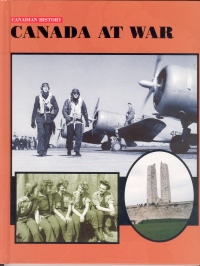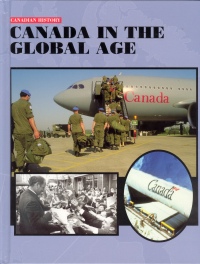| ________________
CM . . .
. Volume XI Number 8 . . . . December 10, 2004
These two titles in Weigl's "Canadian History" series are better than standard social histories of Canada in the 20th century. They are student friendly, well organized, nicely illustrated and sophisticated enough to crossover from the middle to senior school social studies level. Both books contain multiple choice quizzes, glossaries and suggestions for further readings. However, they would have benefitted greatly from a comprehensive introduction, particularly Canada in the Global Age, to place the complex issued discussed in a proper contextual framework. Canada At War begins in 1914, with the origins of World War I, and concludes in 1945 with the end of World War II. Although the nation was ill-prepared, young Canadian men rushed to assist Great Britain in its war against the Central Powers. Dylan Kirk details how the Canadians distinguished themselves in many of the major offensives of the war and gained the respect of both allies and enemies. Meanwhile, he shows how a nascent social revolution was taking place on the home front: the government was forced to take a larger role in planning economic and scientific development; political crises arose over the Conscription Act and the supposed threats from foreign nationals; women had entered the work force to fill the vacancies left by enlisted men and they were demanding social equality. Kirk does a fine job describing the uneasy post-war world. The 1920s and 30s were troubled times in Canada. There was high unemployment, many women wanted to remain in the work force, workers' demands led to unionization, strikes and the formation of new political parties. The 1930s saw even greater social dislocation as the Great Depression gripped the industrialized world, fascism reared its ugly head and the League of Nations failed to stop aggression. Canada was again ill prepared to go to war in 1939, but it did so. The failures and tragedies of the early war years led to victories in the Italian, Normandy and Netherlands campaigns. As the Canadian troops were proving their bravery in Europe, the home front was radically transformed. Women returned to the industrial workforce, and the country shifted from a rural agricultural base to a modern industrial urban economy. Kirk could have developed this section to highlight its fundamental importance to Canada. Without this shift, Canada could not have aspired to a new role as an independent middle-power in the post-war global world. In the aftermath of the war, Canada's economy flourished, its population boomed, and government took a more active role in implementing social and economic policy. As Kirk shows, rapid social change also led to increased demands for social justice in every segment of the population. He looks at the development of feminism, the peace movement, Native activism, western alienation, multiculturalism, the rise of cultural nationalism and the origins of Quebec separatism. As well, he explains how successive governments attempted to deal with these issues through regional development programs, legislation and constitutional amendments. Kirk explores Canada's changing role in the international arena. As the North American and world economies became more integrated, Canada has had to make trade agreements that affect our social structure, our relationship to poorer nations, as well as our political ties to more powerful nations. Kirk makes it clear to students that the global world is an extraordinarily complex place. Hopefully they will see that simple solutions belong to a simpler time. Recommended. Ian Stewart teaches at David Livingstone School in Winnipeg, MB.
To comment
on this title or this review, send mail to cm@umanitoba.ca.
Copyright © the Manitoba Library Association. Reproduction for personal
use is permitted only if this copyright notice is maintained. Any
other reproduction is prohibited without permission.
NEXT REVIEW |TABLE OF CONTENTS FOR THIS ISSUE
- December 10, 2004.
AUTHORS
| TITLES | MEDIA REVIEWS
| PROFILES
| BACK ISSUES
| SEARCH | CMARCHIVE
| HOME |

